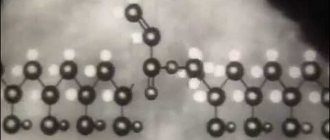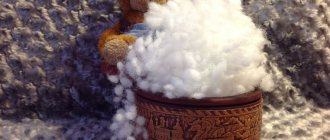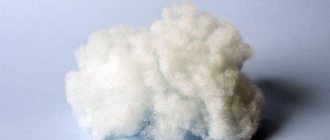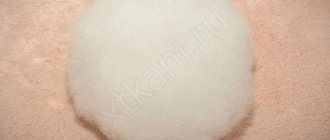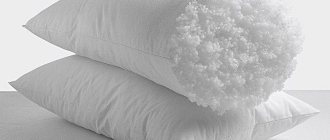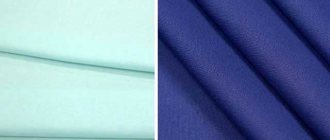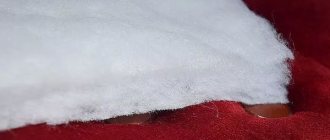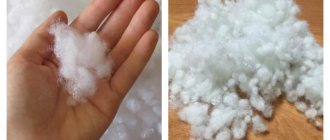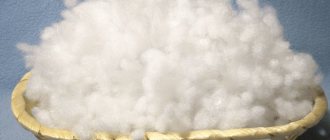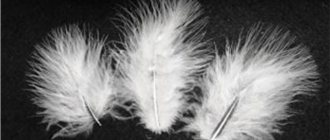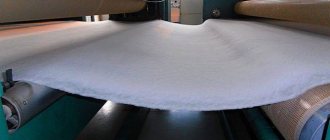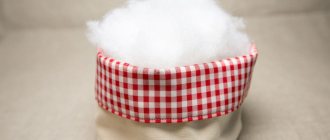When you mention insulation for clothing, one of the first things that comes to mind is holofiber.
In recent years, it has confidently taken a leading position among fillers.
In addition to being used for sewing jackets and down jackets, it is used in the furniture and construction fields.
The raw material for its production is the familiar plastic, from which almost all beverage containers are made, including recycled ones.
In this article we will explain in detail:
- what kind of material is this;
- does it relate to tissues;
- what is it made from;
- what properties does it have?
- how much does holofiber cost?
General concepts and technical characteristics of the material
Holofiber is a thermal insulation material made from polyester fibers . Used as filler and insulation.
It is a nonwoven material that can either be compressed into a roll or formed into a sheet (roll or sheet fill).
To do this, it goes through additional processing stages. The finished presentation is determined by the area of use.
Compound
The vast majority are made from polyethylene terephthalate (polyester, PET, lavsan).
The photo on the right shows what holofiber looks like.
For its manufacture, it is also possible to use recycled plastic , but in this case, the quality of the resulting material will differ slightly from the characteristics of filler made from primary raw materials.
Additionally, can be administered as an enhancing agent :
- components of an elastomeric nature (rubbers) - they increase firmness and elasticity;
- wool - to enhance thermal insulation properties and comfort to wear.
Structure and properties of insulation
Holofiber looks like balls with a loose structure . A large number of air cavities retain heat in the inner layer.
The spherical shape provides good resistance to deformation and rapid recovery after removal of the load . In addition, this material is easier to work with and is convenient for filling small items of clothing and structural parts.
When molded, the fibers are twisted into a spiral. When produced using the wind tunnel method, the directions for the formation of spirals are randomly located, which increases the thermal insulation of the filler.
The surface of the threads is treated with a silicone compound . Surface treatment provides several advantages in the operation of insulation:
- There is virtually no moisture absorption, which allows products to dry faster;
- resistance to caking - when deformed (washing, spinning, pressing, squeezing, etc.), the holofiber elements do not stick together; after the pressure is removed, the original volume is completely returned to the material;
- foreign odors are not absorbed, the surface becomes impervious;
- the material is non-toxic and does not cause allergies - silicone and polyester themselves are neutral and do not harm human health.
Varieties
Depending on the type of polyester (primary or secondary), two types of products :
- 1st grade holofiber - made from pure virgin polyester, characterized by softness and light weight, hypoallergenic, in fact its scope of application is not limited in any way, behaves well in the clothing industry and in the technical industries, and is used as a filler for soft toys;
- holofiber 2nd grade - recycled plastic is used as raw material, the material from it has a shade from light gray to brown, as shown in the photo below (option on the right), it is more rigid, suitable mainly for technical purposes.
Primary or secondary raw materials - what's the difference?
In this section, we will dwell on the distinctive features of holofiber made from recycled raw materials from material made from virgin polyester:
- Recycled PET fibers are stiffer . This property is determined by the fact that it is more difficult to pull a thin thread with good strength from the secondary. Therefore, processors take such a step as thickening the threads.
- Recycled materials have lower resistance to moisture . Recycled plastic is more susceptible to hydrolysis.
- Recycled fibers resistant to stress . For example, when washed, such insulation will lose its shape faster.
- Recycled litter may have an unpleasant odor If raw materials are not properly cleaned of residual contaminants, there is a high probability of an unpleasant odor from the insulation.
Holofiber: what is it?
Holofiber is a synthetic non-woven material. More precisely, this is the name of the trademark under which more than a hundred varieties of this material are produced. Very soon this brand became a household name and all products began to be called “holofiber”. In English, hollow fiber means “hollow (empty) fibers.” Indeed, the filler consists of tiny particles - hollow polyester fibers . To make holofiber, they are twisted and exposed to high temperatures to be soldered together. After such manipulations, the fiber resembles a spring. Thanks to this technology, holofiber has phenomenal resistance to any, even very strong, physical impact. This material was first produced at the Moscow nonwoven materials plant in 2005.
The Holofiber trademark belongs to . This is the only company that produces nonwoven materials under this brand.
Holofiber production
The production of this filler, which has unique properties, is a technically difficult process. For the common man, the production of holofiber is very interesting. It should be noted that the raw material for the material is polyester - a synthetic but non-toxic thread made from polyester fibers .
In general, the manufacturing algorithm looks like this:
- The fiber is heated to 180–2000 Celsius. It is thanks to this that the particles are soldered together without requiring any other chemical reagents. Under the influence of temperature, the fibers form a rigid adhesion, which ensures the unconditional strength of the material.
- After a “hot” reception, the prepared raw materials are sent to a wind tunnel, where the formation of spring fibers will take place. The advantage of this effect is that the fibers will be located randomly, at an angle or vertically.
- The combed fibers are blown with an air stream through a diffuser.
- Then the finished material enters a mesh drum or conveyor.
Filler production technology
The production cycle involves several stages:
- selection of raw materials;
- fiber preparation;
- holofiber molding;
- finishing (coating) with silicone;
- package.
Holofiber is made from virgin and recycled PET. Fundamentally, the equipment for the production of holofiber itself is the same. The settings of process parameters may differ: temperature, feed rate, etc.
That is, filler molding machine is universal and can work on polyester fiber of any nature. Pure polyester fiber is ideal for any purpose, it is light, transparent and clean. Threads made from regranulate most often have a grayish tint, so they are suitable mainly for technical products.
The decisive factor is the cost of raw materials. Recycled polyester is cheaper , and, in addition, serious competition in the PET recycling market is pushing recyclers to improve product quality.
You can buy ready-made fiber, or
you can produce it yourself .
A more detailed description of the process of forming fibers can be found in the articles “Synthetic flakes” and “Flex flakes: types, production, application.”
A significant advantage of making threads yourself is the ability to manage quality .
The serious disadvantages are very expensive equipment and the need for qualified personnel.
At the fiber preparation stage
polyester threads are pre-cut and combed using a carding machine. This is how the fibers acquire a three-dimensional structure.
When molding holofiber
There are currently 2 technologies in use:
- calender method - pieces of polyester are fed into a narrow gap between two shafts, which rotate at different speeds, the small shaft guides the fibers and rotates faster, and the large (heated) shaft - slower, it picks up the threads and twists them into balls;
- aerodynamic method - cut pieces are fed into a pipe diffuser and move towards the outlet in a stream of hot air, the threads are curled up under the influence of heat (one of the fundamental properties of polymers works here - when heated, the interaction between the polymer links is weakened, and the molecule twists into its natural state - a ball) .
Finishing or application of silicone liquid occurs inside the chamber using spray guns.
By forming a thin surface layer, silicone protects the surface of the holofiber from moisture, absorption of unpleasant odors and caking.
Finished products are packaged in polyethylene . To increase compactness, the bags are packed under vacuum.
Differences
The main difference between these fillers is the form they take after processing the raw materials. Holofiber takes the form of balls, synthetic fluff forms springs.
Synthetic down is washable, unlike its competitor, which loses its properties when exposed to high temperatures. The fact is that the fibers are connected to each other by an adhesive composition. Hot water destroys this bond, which leads to loss of softness and elasticity.
Although synthetic fluff has no restrictions on care, it has a higher price.
Areas of use
First of all, holofiber was invented as an improved filler for textile production. It is more technologically advanced to use than synthetic winterizer and natural insulation materials (wool, batting, etc.). Its areas of application are varied - from sewing outerwear to construction purposes.
Areas of application depend on its type :
- Soft . Density 150 g/m2. Light and fluffy. Used for outerwear as a filler.
- Average . Density 200 g/m2. More dense and heavier. It is mainly used for the production of home textiles and for the top layer in upholstered furniture structures, filling bulk products.
- Hard . Density 200 g/m2. Dense, shape-stable. Used as a filler for upholstered furniture.
It should be noted that the use of 2nd grade holofiber is limited due to its technical characteristics, which are inferior to 1st grade material.
Permitted areas of use of insulation from PET waste include:
- construction - it is much lighter than foamed polyethylene and other analogues, in addition it has an attractive price, it is used as insulation for walls, ceilings, roofing, etc.;
- furniture - used as a rigid upholstery material for furniture production, since holofiber made from thick threads of recycled PET is quite durable;
- as a filler for inexpensive clothing - for sewing special clothing with a short service life, it is permissible to use insulation from recycled materials.
Everything is relative
For many, holofiber, padding polyester, padding polyester are one and the same thing. But this is far from true. What is the difference between this filler and its competitors?
Holofiber and padding polyester
It must be said that these two materials are very similar in appearance. True, padding polyester is “older” than its competitor. It began to be used back in the late 40s of the last century, while holofiber is a little over ten years old. The main difference between these materials is the manufacturing method. Hollow fiber is created by exposing polyester fibers to hot air. To produce padding polyester, an emulsion of PVA glue is used, which makes it not as safe and environmentally friendly as holofiber. And also it does not allow air to pass through so well and is less hygroscopic . If you get caught in the rain in a padding polyester jacket, you risk getting wet to the skin, and, alas, severe frosts are too much for him. Holofiber keeps its shape perfectly, quickly recovering from even strong physical impact, which cannot be said about its “sworn friend”. Synthetic winterizer cakes over time, and after frequent washing it begins to deform. The only advantage of padding polyester is the price: holofiber is much more expensive.
Holofiber and synthetic fluff
The manufacturing process of these two materials, as well as their characteristics, are approximately similar. The production is based on the same hollow fibers. Thanks to this, synthetic fluff, like holofiber, is resistant to deformation and does not clump after frequent washing. Both materials are hypoallergenic, environmentally friendly, reliable and durable . The difference between them is in the structure. Synthetic down resembles natural down, only even softer and lighter; holofiber can have a different structure from balls to canvases and even hard slabs.
Holofiber and down feather
The only advantage of natural fillers remains in their naturalness and environmental friendliness. It is these seemingly remarkable properties that create a favorable environment for the habitat of annoying neighbors - dust mites and other equally “attractive” microorganisms.
Down and feather filling loses on many points: hypoallergenicity, wear resistance, durability, price, ability to keep its shape . Someone may notice that down filling is the warmest. Yes, this is an excellent insulation, but holofiber can compete with that! It’s not for nothing that it is used for workwear with critically low temperatures. Products with holofiber perfectly withstand the test of an automatic machine; for down, especially with the addition of feathers, such a procedure can often be disastrous.
I remember in the early nineties, when I reached my age, it was decided to buy me a new “adult” coat for the winter. The store shelves did not please with the assortment, so my mother and I went to the local market, then called “flea market”. It used to be that they used to sell second-hand things at flea markets; in the heady nineties, a new class was born - Chelnok. This is where we approached the tent of such a shuttle. It was some kind of miracle: not a jacket, but not a coat either. Fashionable style, bright colors, zippers, rivets! I was dizzy from such beauty. To my mother’s question: how much does such a coat cost? — the seller with an important look said that this was not a coat, but a down jacket. “With feathers? - Mom was surprised. “No, we don’t need that.” After much persuasion, my mother agreed. Looking ahead, I will say that my mother was right... The problems began on the first day. A feather was mercilessly coming out of the down jacket. My classmates teased me with the “chicken coop” for a long time. But the main problem was ahead. After washing, the filler formed into lumps of different sizes and despite all my mother’s efforts, there was no way to get the coat in proper shape. Moreover, after the fashionable coat dried, the smell of rotten feathers emanated from it and yellow stains remained on the fabric. The rest of the winter I wore an old coat...
Trust but check
To determine which filler the manufacturer used, just look at the tag or label. Conscientious companies not only provide truthful information on the composition, but also attach a special transparent bag with a sample of insulation . Found your treasured bag? This means that this is a high-quality, non-counterfeit product. By appearance, you can easily determine what will be hidden under the lining of the down jacket.
What to do if there is no such bag and you are tormented by doubts about the filler? Trust tactile sensations:
- Squeeze part of the product in your fist. Holofiber will very quickly return to shape, and padding polyester will “think” before restoring volume.
- Rub part of the item between your index finger and thumb. The fluff will easily “scatter” in different directions and only fabric will remain between your fingers. From such an impact the synthetic fluff will shrink to a very thin layer. But you will still feel its presence.
- Try stretching the fabric slightly. If you hear a characteristic crunch or slight creaking, it’s padding polyester. Holofiber will not make a sound.
Another distinctive feature of fillers is price . The most expensive products, of course, are made from natural down. Then from synthetic fluff and holofiber. The cheapest products will be made from padding polyester.
Price for 1 kg
Holofiber is a material with an attractive price. To understand the price of filler, you can consider approximate offers for Russian cities . The table shows prices for 1 kg of 2nd grade holofiber:
| City | Price per 1 kg/rub |
| Moscow | 250 |
| Saint Petersburg | 250 |
| Krasnodar | 160 |
| Volgograd | 150 |
| Ekaterinburg | 150 |
| Tomsk | 130 |
| Novosibirsk | 150 |
| Vladivostok | 250 |
Care
Another advantage of holofiber is ease of care. The unpretentious and durable material does not require any special conditions to maintain cleanliness. It withstands repeated washing in an automatic machine, as well as dry steam treatment. It dries fairly quickly at room temperature. And what is important is that it does not become electrified and does not shrink . Don't forget that this only applies to holofiber. If this wonderful material can even be boiled, then the outer fabric in which the filler is wrapped probably has its own care rules, so carefully study the composition of the fabric on the label. But holofiber is not afraid of any washing.
Do I need to iron products with holofiber? Again, if the top layer of fabric requires it. But basically ironing is not necessary, because this filler holds its shape perfectly.
Video: the whole truth about holofiber in questions and answers
Recommendations for product care
Products filled with synthetic down require compliance with some simple care rules:
- Hand and machine washable, water temperature no more than 90°C, delicate cycle;
- Machine spinning and drying allowed;
- ironing at a temperature of less than 100°C;
- hanging drying of products;
- storage in any conditions, including in vacuum bags.
Synthetic fluff is a durable material that, when used correctly, retains all its positive qualities. Products with this filler will serve faithfully for many years.
